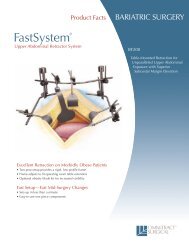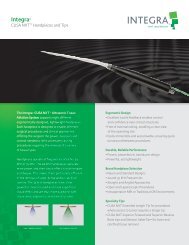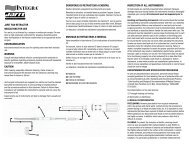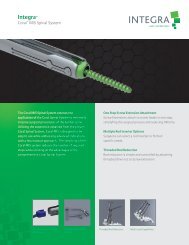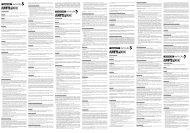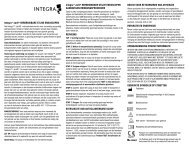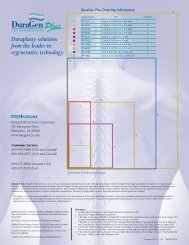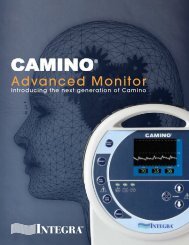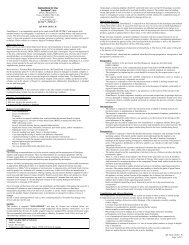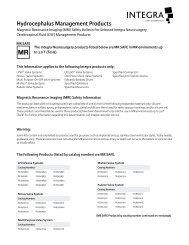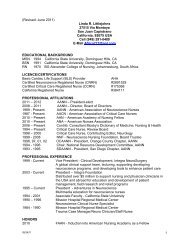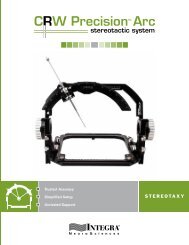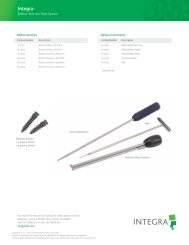Equi-Flow Valve IFU
Equi-Flow Valve IFU
Equi-Flow Valve IFU
You also want an ePaper? Increase the reach of your titles
YUMPU automatically turns print PDFs into web optimized ePapers that Google loves.
EnglishOccluderSiliconeDomeReservoirTantalumPressureDotsTantalumDirectionalArrowOccluderSiphonLimitingDeviceInletConnectorReinforcedSheetingPolypropyleneNeedle GuardSiliconeMembraneOutletConnectorDESCRIPTIONThe Integra <strong>Equi</strong>-<strong>Flow</strong> <strong>Valve</strong> is a multi-function membrane valve incorporating a normally open Siphon LimitingDevice, occluders, and integral tubing connectors. It is used in treatment of patients with hydrocephalus when shuntingcerebrospinal fluid (CSF) from ventricles of the brain. It incorporates a central reservoir for pumping and injection,proximal and distal occluders, a Siphon Limiting Device and a fully flexible profile. The Siphon Limiting Device limitsthe reduction of intraventricular pressure and volume caused by the siphoning effect of hydrostatic pressure in the DistalCatheter.The <strong>Equi</strong>-<strong>Flow</strong> <strong>Valve</strong> design includes a flat silicone membrane, which provides resistance to CSF flow. The flat siliconemembrane seats on a conical polypropylene base which is integral to the Siphon Limiting Device. The Siphon LimitingDevice contains a rigid outlet port. This design allows for accurate and precise regulation of CSF flow due to itsstructural integrity. The flat silicone membrane also prevents retrograde flow of CSF.The <strong>Equi</strong>-<strong>Flow</strong> <strong>Valve</strong> is available in two sizes: Regular and Small. Both sizes are available in 4 pressure/flowcharacteristics ranges: Performance levels 0.5, 1.0, 1.5 and 2. The pressure/flow characteristics of both sizes of theIntegra <strong>Equi</strong>-<strong>Flow</strong> <strong>Valve</strong> are shown in the graph (Figure 1) and chart (Figure 3). These pressure values are derived as thevalve is tested at flow rates varying from 5 to 50 ml/hr. Each valve is individually tested to obtain its pressure/flowcharacteristics, closing pressure (Figure 2), and its ability to prevent retrograde fluid flow. The tantalum impregnatedsilicone arrow and pressure dot code on the valve housing allow identification of the pressure/flow rating. Each valve isdot-coded based on its horizontal and vertical operating pressures measured at the time of manufacture. The pressure ofeach valve has been verified to be within the pressure range limits indicated on the package label.The <strong>Equi</strong>-<strong>Flow</strong> <strong>Valve</strong> is designed with a fully flexible profile to conform to the curvature of the skull.The <strong>Valve</strong>’s integral tubing connectors present an outer diameter of 1.8 mm for connection to standard catheters.The <strong>Equi</strong>-<strong>Flow</strong> <strong>Valve</strong> may be flushed in either the proximal or distal direction by pressing one of the occluders on thevalve and pressing the reservoir. The reservoir is designed to allow penetration with a 25-gauge or smaller beveledneedle. The reservoir contains a polypropylene needle guard to prevent overpenetration of the needle. The valvemembrane is further protected from needle punctures by a rigid polypropylene cartridge.Magnetic Resonance Imaging (MRI)/CT CompatibilityThe <strong>Equi</strong>-<strong>Flow</strong> <strong>Valve</strong> is made of materials that are known not to interfere with CT scans or MRI imaging. Caution shouldbe exercised to ensure that the device is not connected to components that may contain interfering or non-compatiblematerials.MaterialsThe entire bottom surface of the <strong>Equi</strong>-<strong>Flow</strong> <strong>Valve</strong> is constructed of barium-sulfate impregnated silicone elastomer. It alsocontains polyester reinforced sheeting, which is fully encapsulated by silicone elastomer to prevent contact with tissuesor fluids. The <strong>Equi</strong>-<strong>Flow</strong> <strong>Valve</strong> is latex free.Materials in contact with body tissues or body fluids are silicone elastomer with or without barium sulfate,polypropylene with or without barium sulfate, silicone ink and stainless steel.ConfigurationsThe System is available in different configurations; a system generally consists of a ventricular (proximal) catheter, avalve unit, and a drainage (distal) catheter. The drainage catheter may be integral (attached to the valve) or separate.Some configurations contain a burr hole cap and a burr hole reservoir. Included with the <strong>Equi</strong>-<strong>Flow</strong> shunt systems thathave a ventricular catheter are one introducing rod (stylet) and one Right-Angle Guide (RAG).4




